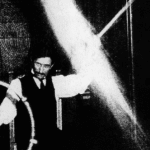 Technology
Technology  Technology
Technology  Humans
Humans 10 Everyday Human Behaviors That Are Actually Survival Instincts
 Animals
Animals 10 Animals That Humiliated and Harmed Historical Leaders
 History
History 10 Most Influential Protests in Modern History
 Creepy
Creepy 10 More Representations of Death from Myth, Legend, and Folktale
 Technology
Technology 10 Scientific Breakthroughs of 2025 That’ll Change Everything
 Our World
Our World 10 Ways Icelandic Culture Makes Other Countries Look Boring
 Misconceptions
Misconceptions 10 Common Misconceptions About the Victorian Era
 Mysteries
Mysteries 10 Strange Unexplained Mysteries of 2025
 Miscellaneous
Miscellaneous 10 of History’s Most Bell-Ringing Finishing Moves
 Technology
Technology Top 10 Everyday Tech Buzzwords That Hide a Darker Past
 Humans
Humans 10 Everyday Human Behaviors That Are Actually Survival Instincts
 Animals
Animals 10 Animals That Humiliated and Harmed Historical Leaders
Who's Behind Listverse?

Jamie Frater
Head Editor
Jamie founded Listverse due to an insatiable desire to share fascinating, obscure, and bizarre facts. He has been a guest speaker on numerous national radio and television stations and is a five time published author.
More About Us History
History 10 Most Influential Protests in Modern History
 Creepy
Creepy 10 More Representations of Death from Myth, Legend, and Folktale
 Technology
Technology 10 Scientific Breakthroughs of 2025 That’ll Change Everything
 Our World
Our World 10 Ways Icelandic Culture Makes Other Countries Look Boring
 Misconceptions
Misconceptions 10 Common Misconceptions About the Victorian Era
 Mysteries
Mysteries 10 Strange Unexplained Mysteries of 2025
 Miscellaneous
Miscellaneous 10 of History’s Most Bell-Ringing Finishing Moves
10 Weird Royal Traditions Throughout History
Welcome to the downright bizarre world of royal traditions. Throughout history, monarchies have been a breeding ground for eccentric customs that will have you scratching your head in disbelief. Join us on a whimsical journey as we explore ten weird royal traditions throughout history that will make you wonder, “What were they thinking?”
Related: Ten Tough & Terrible Queens Who Ruthlessly Ruled Their World
10 Step Lightly: Quirky Christmas Dinner Weigh-Ins
The holiday season is a time for joy, merriment, and, apparently, stepping on the scales before dinner. Believe it or not, there was a peculiar tradition among some European royals that literally turned Christmas dinner into a weighty affair.
It’s Christmas Eve, and instead of decking the halls, the royal family is lining up to step on the scales. Why, you ask? Some royal households—notably the Habsburgs of Austria—had a rather unique way of ensuring their holiday indulgences didn’t get out of hand.
The Habsburgs, renowned for their abundant feasts and lavish celebrations, aggressively prevented their royal waistlines from expanding too much. Before sitting down to enjoy their festive feast, each family member was required to do a pre-dinner weigh-in. If the numbers on the scale had surged since their last weigh-in, well, it wasn’t exactly a silent night for the guilty party.
Imagine the dinner table discussions: “Oh dear, looks like Prince Leopold had one too many mince pies this year.” It’s like a royal version of The Biggest Loser, but with more crowns and fewer treadmills.
9 Royal Romance: The Tradition of Approval for Matrimony or No Crown
In the annals of regal history, the tradition of needing matrimonial approval—or no crown—stands out for all the wrong reasons. Picture a dashing prince and a lovely princess falling head over heels in love, but hold your horses. Before they can waltz down the aisle, they must pass the ultimate test: the royal stamp of approval.
Dating back to medieval times, this tradition was no mere formality. It was the royal equivalent of a high-stakes poker game. Marriages weren’t just about romance. They were political maneuvers. Alliances forged over goblets of mead and courtly intrigue. So, when Prince Charming came knocking, he had to get a thumbs-up from the powers that be.
Imagine the nerve-racking scene: The prince sweating bullets, the princess anxiously twirling her locks, and the courtiers whispering like gossip-hungry magpies. If the monarch didn’t deem the match suitable, sorry, Charlie, but no crown for you!
But love has often found a way to triumph over tradition. History is brimming with tales of star-crossed lovers defying the odds, from secret rendezvous to daring elopements.
8 Record Every Gift: A Royal Ritual of Extravagance
Imagine keeping a meticulous log of every gift you receive—every trinket, bauble, and treasure. Sounds exhausting, right? For royals throughout history, this was not just a quirk but a grand tradition.
In the hallowed halls of monarchy, recording gifts was a display of luxury, a testament to the wealth and influence of the crown. From the shimmering jewels bestowed by foreign dignitaries to the exotic animals gifted by distant lands, every present was carefully cataloged.
Back in the days when kingdoms held sway over other realms, receiving gifts was a diplomatic dance. A grand gesture from a neighboring monarch could signify allegiance or alliance. At the same time, a rare artifact from a distant land could hint at trade opportunities or political favor.
Let’s not forget the sheer extravagance of it all. Picture rooms overflowing with priceless artifacts, shelves bending under the weight of ornate trinkets, and scribes scribbling away to document each item—a spectacle fit for the grandest royal courts.
7 Travel Tango: Required Separate Carriages for Direct Heirs
One of the most peculiar traditions throughout history has been the notion that direct heirs cannot travel together. Picture a royal family embarking on a journey, but wait! The heir to the throne and their immediate successor cannot share the same mode of transportation. It’s like a real-life game of royal chess with carriages instead of pawns.
Dating back centuries, this tradition stems from the need to protect the lineage and ensure the monarchy’s survival. Imagine the horror if both the king and his heir were to meet an untimely demise on the same treacherous journey. It’d be a royal catastrophe.
Historically, this rule has led to some pretty extravagant travel arrangements. Separate carriages, different ships, you name it. Anything to ensure the bloodline stays intact and the kingdom doesn’t descend into chaos.
But let’s be real here: it’s also a logistical nightmare. Can you imagine the scheduling conflicts and the sheer amount of extra planning required to move the royal family from point A to point B?
Talk about drama behind the scenes.
6 Royal No-Go: The Monopoly Ban in High Society
Monopoly is the game of financial domination and family feuds. But guess what? Playing Monopoly was a definite no-go for royal families. Surprised? So was I when I stumbled upon this quirky tradition.
While the rest of us peasants are busy bankrupting each other in friendly Monopoly battles, royals have a strict rule against it. Why? Well, it hits too close to home for their liking. Monopoly’s ruthless property trading and monopolistic tendencies didn’t sit well with certain monarchies who preferred to maintain a more, shall we say, dignified image.
The British royal family, known for their love of games and sports, reportedly banned Monopoly altogether from their residences. Can you imagine the king flipping the board because someone landed on Park Place with a hotel? Unthinkable!
Hey, who needs Monopoly when you’ve got real castles and estates to manage? Plus, with all the political and economic power struggles, the last thing these royals needed was a reminder of their own potential financial downfalls.
5 Hats Off to Tradition: The Royal Command of Women’s Headwear
Stepping back to when fashion rules were as rigid as castle walls, we stumble upon a peculiar royal tradition that adds a dash of eccentricity to formal affairs: mandatory hats for women. A hat is not just a stylish accessory. It’s a decree as old as time (well, at least a few centuries). The trend dates back to the 18th century when hats were both a fashion statement AND a symbol of social standing.
In the court of Queen Victoria, donning a hat was a non-negotiable ticket to the party. The bigger, the better – as if each hat had a secret mission to outshine the chandeliers. Ladies of the court competed in grace and the height of their headgear. Rumor has it that the taller the hat, the closer one stood to the throne—an unspoken hierarchy etched in feathers and ribbons.
Fast forward to the present day, and while we may have traded elaborate headpieces for sleek fascinators, the tradition lives on. Even in modern times, royal events see a sea of hats bobbing like ships in a regal sea.
4 Drenched in Royalty: The Tradition of Mandatory Royal Baptisms
In the wild and wacky world of royal traditions, here’s a gem that might make you do a double-take: the requirement that every royal offspring take the plunge—quite literally —into the world of baptism. Across various royal families throughout history, this ritual wasn’t just a quaint religious ceremony. It was practically a must-do on the royal to-do list.
Picture little princes and princesses, barely out of their royal cribs, getting doused in holy water with the kind of flair that would make a seasoned water park enthusiast jealous. The tradition, rooted in the belief that baptism cleanses the soul and secures a divine favor, has seen its fair share of quirks.
In medieval Europe, royal babies were baptized in style. Some ceremonies featured ornate golden fonts, while others boasted exclusive guest lists that make Hollywood red carpets look like casual backyard gatherings. The grandiosity of these events wasn’t just for show—it was a way to reinforce the idea that the royal bloodline was heaven-approved.
3 The Dinner Dilemma: If the Queen Isn’t Eating, You Don’t Get to Either!
Imagine being seated at the grand dining table of Buckingham Palace, eagerly eyeing those scrumptious hors d’oeuvres, but wait—there’s a catch. If Her Majesty isn’t nibbling away, neither are you! It’s like a high-stakes game of gastronomic roulette, where your appetite is at the mercy of the queen’s.
This tradition traces back to the days of yore when monarchs held the absolute power of life, death, and dinner. If Queen Victoria decided to push her plate aside, you could forget about indulging in those delectable delights. It was as if the very act of chewing was subject to royal approval.
This tradition still holds sway in the hallowed halls of Buckingham Palace. So, next time you find yourself in the king or queen’s company for a meal, keep a keen eye on the royal fork. If it’s resting peacefully on the porcelain, you might want to reconsider reaching for that Yorkshire pudding.
2 Royal Jetsetters: Pack One Black Outfit
Among the royal customs lies a peculiar mandate: Royals must pack one black outfit. Amid the opulent trunks filled with coronation robes and diamond-encrusted tiaras, there lurks a single garment of mourning.
Dating back to the Victorian era, this tradition found its roots in royal travel etiquette. Royals were expected to be prepared for any eventuality, including the untimely demise of a fellow monarch or dignitary. Thus, providing a black ensemble ensured they could appropriately mourn should the need arise.
Over time, the tradition has evolved from a practical necessity to a symbolic nod to tradition and decorum. In today’s world of private jets and high-speed trains, the need for mourning attire may seem out-of-date. Still, it endures as a testament to the enduring rituals of royalty.
1 Shell Shock: The Forbidden Takeout Tale in Royal Cuisine
One eyebrow-raising custom stands out in royal traditions: the ban on shellfish takeout. Believe it or not, history has witnessed royal palates steering clear of seafood-to-go, and it’s not just about avoiding soggy fries. Dating back to medieval times, this peculiar practice originated from the fear of food poisoning, as shellfish tend to spoil quickly.
Picture knights in shining armor fighting dragons, only to be defeated by a bad batch of oysters. It might sound like a satirical tale, but monarchs took this ban seriously for centuries. The notorious King George II of England was so paranoid about potential foodborne illnesses that he abstained from indulging in the delights of shellfish outside the palace walls.
This gastronomic decree extended to royal banquets and state affairs, leaving royal chefs puzzled about how to serve up a lavish seafood spread without risking the wrath of a stomach rebellion. Fast forward to the present day, and while food safety standards have drastically improved, the ban on shellfish takeout remains a whimsical nod to a time when even kings feared the wrath of a rebellious lobster.








